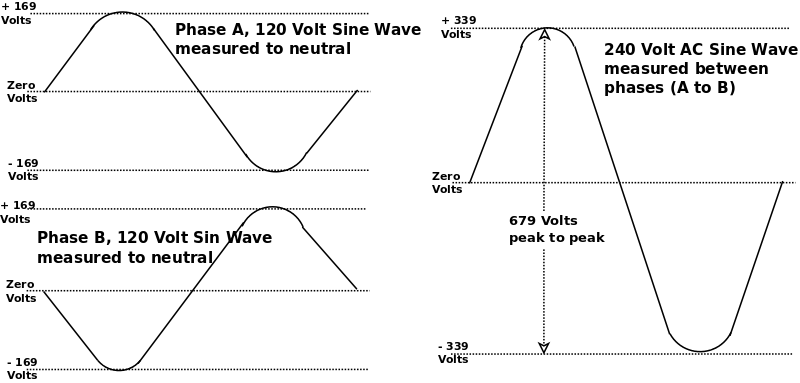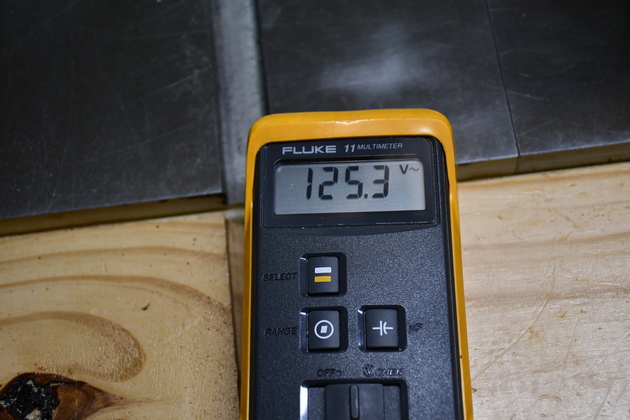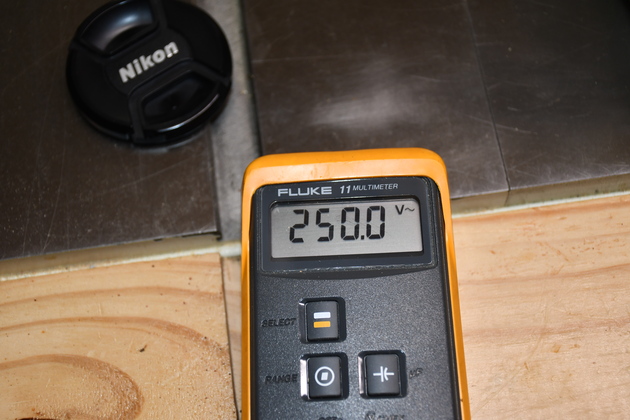
Most folks don't really consider the difference between 120 Volt AC in their home and 240 Volt AC, one just seems double the other and thats correct.
A normal 60 Hz 120 volt AC voltage cycles from zero, to +169, back to zero, then to -169, and back to zero again.
Tuck this under a brain cell, alternating current (AC) flows both ways in your home's wiring.
The wiring in a residence 120 Volt AC consists of a green (or bare copper) wire, Ground, a white wire, Neutral, and a black wire, Hot.
The Neutral and ground are at the same potential (voltage) or zero volts, they are tied together in your main breaker box, and nowhere else in your home.
You should never have current flowing through your ground wire.
Current should only flow between the hot (black) wire and the neutral (white) wire.
In the following examples, I am talking about a 20 Amp circuit, if a different amperage is needed, change the wire and breaker size.
Normally, 240 uses 12-3 with gnd, Black wire (hot), red wire (hot), white wire (neutral), and green or bare copper (ground), in this case you may draw current from either hot wire to neutral, or 240 from both hot wires.
I you only need single phase 240 it can be run over 12-2 with gnd, (black, white, bare copper) by putting red tape on the white wire and making it hot.
If you look at a residence 120 Volt AC (with an oscilloscope) you would see a sine wave, like one of the two on the left in the diagram.
But the phase (relationship of where the zero voltage points are) of the two signals is a lot different
A normal residence is supplied with two phases of 120 Volt AC, the two phases are exaclty 180° out of phase (phase reversed).
You may draw current between either of the phase wires and neutral or from one phase wire (phase A for instance) to the other (phase B).

| 120 Volt vs 240 Volt |
AC voltage is usually measured as RMS (Root Mean Squared) which represents the DC (Direct Current) value, or the ability to do work. Another way to think of it is if you put 100 VAC across a resistor the resistor would heat up the same as putting 100 VDC across it. A carbon resistor, for instance, is pure resistance, in that it doesn not react to the AC voltage differently than DC voltage. You'll notice, in the diagram above, the peak voltage (from zero volts to it's highest or lowest value) is much larger than the RMS value. Some time peak to peak is needed (for calculations) which is double the peak voltage. You must always be aware that the kind of load across an AC voltage determines how much current is drawn. For instance if you put 100 VAC across a coil of wire, the coil will have what is called reactance, that is, it resists the flow of alternating current. The reason a coil has reactance, any time you send a currtent through a conductor (wire) it produces a magnetic field around the wire and any time a magnetic field cuts across a conductor a voltage is induced in the conductor. Now when the conductor is wound into a coil, the magnetic field from one part of the conductor cuts other parts of the conductor attempting to create a current, usually in the reverse direction to the original current. Since we are applying an Alternating Current, the magnetic field is constantly rising and falling, cutting other parts of the coil creating rising and falling voltage to oppose the AC we are applying (reverse current). So this reverse current being created in the coil is opposing the current being applied making the coil appear as if it were a resistor to the AC voltage being applied.
In case your wondering why I always talk about 240 Volt and 120 Volts at home, here are the voltages measured on both my Fluke VOMs. The local power company keeps our lines at 125 and 250, not 115 Volts and 220 VOlts.

|
One phase of my home power, 125.3 VOlts. |

|
Across both phases 250Volts. |